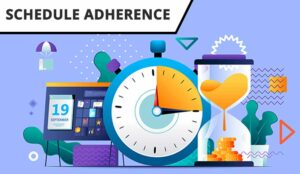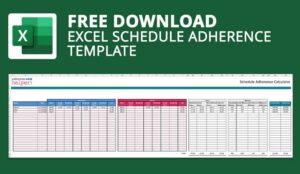Our panel of experts recommend their favourite methods for improving schedule adherence in the contact centre.
1. Discuss the Importance of Schedule Adherence From Day One
Advisors need to understand the importance of schedule adherence from day one.
Provide the team with power of one training during the onboarding process.
Provide the team with power of one training during the onboarding process. This will reduce the risk of bad habits developing.
To help keep your teams on track of their schedule adherence, use technology that can help with things like monitoring breaks and active time in the office.
Show team members how to change their status on group collaboration apps and let them know who they need to contact about breaks.
When training for productivity, you may even encounter areas where you can automate repetitive tasks and eliminate time wasters.
2. Provide Some Flexibility
Employees without any give in their schedules are less likely to stick with them.
While a good schedule is essential, workforce management tools that allow advisors to adjust their shifts where necessary might improve adherence. You could even offer tools that allow advisors to swap shifts without excessive paperwork.
Offer tools that allow advisors to swap shifts without excessive paperwork.
Remember that the best advisors occasionally get stuck in traffic or are unable to visit the office. With that in mind, ensure you have adherence exceptions in place for different scenarios.
Also, it’s helpful to have the option for employees to log into the workplace from home and work remotely when in-office interactions aren’t an option.
3. Embed Adherence Into Company Culture
Emphasizing how important it is for team members to follow the schedule guidelines can inspire them to be more productive, and available.
Creating a culture of fairness where expectations are clear is a good way to boost adherence and engagement.

Make sure employees that do a good job of sticking to schedules get recognition for that.
To further strengthen your chances of success, make sure employees that do a good job of sticking to schedules get recognition for that. Workers should receive rewards for their hard work.
However, avoid punishing tardiness when you can. It’s better for employees struggling with lateness to see other employees being rewarded for their hard work.
4. Monitor Everything
The only way to ensure your efforts with scheduling are working is to keep track of everything and monitor the results.
By using call centre technology, you can monitor advisor status, and identify how they’re really spending their time.

Sam O’Brien
If your advisors are setting their status to busy when they’re not active – what’s really happening?
In cases where you find that certain advisors aren’t adhering to their schedules, offer them productive feedback. Identify why they’re not adhering to the schedule and ask them for any insights into what they might think would work better.
If they need extra help to reach their goals, then consider putting some training solutions in place.
Thanks to Sam O’Brien at RingCentral
5. Make Shift-Swapping Easy
We have all been in a situation where we’ve needed and/or wanted the day off at the last minute. Allowing agents to trade shifts when needed has shown to significantly improve schedule adherence as they are able to swap shifts with colleagues on days they are running late or absent.

Neil Draycott
Swapping shifts also provides agents with more flexibility, allowing them to handle personal responsibilities as they arise, without having a negative impact on the business. It’s also shown to improve employee engagement and satisfaction, having an overall positive effect on their performance.
Many WFM tools now offer a shift-trade module, which for some are fully automated, allowing agents to view their colleagues’ schedules to trade shifts for one or more days based on business rules set up by the planning team. This ensures service levels are maintained whilst also improving agent satisfaction.
Thanks to Neil Draycott at Business Systems
6. Explain Why Adhering to Schedules Is in Their Best Interest
Like anything, there is a “what’s in it for me” component that advisors must understand too. Help advisors understand how adhering to their schedule benefits them.
When an advisor is not adhering to their schedule, occupancy can rise…
Being on the phone at the right times makes the life of the advisor’s team easier, as when an advisor is not adhering to their schedule, occupancy can rise, meaning that the rest of the team has less time to destress between calls.
Also, adhering to schedules is best for an advisor in a sales environment too, as the resource planning team is scheduling them to be on the phone based on volumes.
So, help them understand that not being on the phone during those potentially “peak” times can prevent them from receiving more of those money-making calls!
7. Educate Advisors on the Entire Scheduling Process
Advisors need to know their schedule adherence goal and how they are performing related to the goal and to be held accountable for hitting the goal.
But, before we scold advisors for non-adherence, we need to ensure they understand basic scheduling principles and how they are applied in the contact centre.
Sometimes advisors don’t understand how schedules are created…
Sometimes advisors don’t understand how schedules are created, and how they are truly optimized via forecasting to have the right number of people, in the right place, at the right time to best support customers.
Unless they have worked as a workforce manager before, they may think that someone just creates the schedule ad hoc based on whims!
Helping them understand how schedules are created utilizing sophisticated algorithms and scheduling logic may better reinforce the need for them to follow their schedules.
8. Make Schedule Adherence Stats Visible (and Incentivize Them)
Once knowledge of the importance of schedule adherence is established on the contact centre floor, advisors will hopefully be more accountable for their schedules and improve adherence.
Nonetheless, it is only human nature to revert to old habits and slip up in adherence.

Lauren Comer
The best way to keep schedule adherence top of mind is to use workforce management (WFM) software that lets advisors see their schedule adherence on an ongoing basis.
Also, make hitting a certain threshold of adherence a requisite to earn other incentives in the contact centre.
Following your schedule is the bare minimum for doing your job, so an advisor must do the bare minimum before they can start earning extra on top.
Thanks to Lauren Comer at NICE InContact
9. Rethink Your Schedule Adherence Thresholds
Within WFM, many contact centres apply a threshold on scheduled activities where advisors have an “allowable” amount of time in which they can be late for an activity without it affecting their adherence score.
While this comes from a place of well-meaning, it has two main negative effects:
- Employees soon become aware of the threshold and instead of rushing to be on time, they naturally allow their sense of urgency to drift out until the threshold is up.
- These thresholds cover up where employees are not able to work as scheduled, making it harder to understand why service levels were not achieved because adherence scores are being artificially inflated.

Craig Farley
Quite simply, in order to see the full-service level achievement picture, adherence should be a measure of how well a plan is achieved throughout the day.
Eliminating, or at least reducing, thresholds will not improve adherence scores, but it will improve adherence – which is the important part.
Just make sure to recalibrate any adherence targets to better reflect this more realistic approach.
Thanks to Craig Farley at IP Integration
10. Design Shift Patterns to Match Lifestyles
Advisors are human beings with different needs and are not just robots that can be placed into a timeslot, so design shifts that fit with real human lives – especially in light of the rise in remote working.
Collaborate with the team and ask them when and how they would prefer to work. Offer flexibility from standard shifts and generate smart scheduling practices that account for workload and advisor needs in real time.

Generate smart scheduling practices that account for workload and advisor needs in real time.
Empowering advisors to control their schedules through self-service adds value, as engaged employees provide the highest levels of customer experience.
Despite the well-known link between employee engagement and customer satisfaction, it is difficult to get the balance right between advisor preference and contact centre performance in the field of WFM.
But if you can restructure your shift patterns to meet lifestyles and offer more flexibility, your schedule adherence statistics are likely to greatly improve.
11. Ensure That Adherence Targets Are Not Endangering Customer Experience
Avoid stringent adherence targets driving the wrong customer experience outcomes. This can happen if advisors feel they need to cut interactions short or don’t complete wrap-up notes for fear of being penalized.
A sudden change in the number of interactions with longer handling times would influence adherence targets.
Also, give weight to actual demand. For example, a sudden change in the number of interactions with longer handling times would influence adherence targets.
Static targets do not truly reflect adherence. Be agile with your updates, so advisors are not penalized for out-of-date schedules. Make allowances for impacting active advisors who have to deal with scheduling changes.
Real-time adherence tools now make this possible, especially for large contact centres, where manual administration can be practically impossible.
12. Remember, One Size Does Not Fit All to Schedule Adherence
The huge shift to remote working has made it more important than ever that advisors adhere to their schedules. However, there is no magic formula that can be applied uniformly.

Magnus Geverts
Operational efficiency and increased productivity leads to improved customer satisfaction, and schedule adherence plays a vital part in that process when combined with accurate forecasting and intraday management tools.
Because adherence targets cannot be a one-size fits all, measurement methods should be tailored to each unique contact centre environment.
Resource managers will have to recalibrate the perfect formula to suit their own set-up, be it omnichannel, single interactions, evolving work from home, virtual or traditional office-based centres.
Thanks to Magnus Geverts at Calabrio
13. Consider How Occupancy Impacts Schedule Adherence
Be sure to watch out for occupancy rates that are too high, which can cause advisor burnout and result in increased adherence and absenteeism problems.
The general principle is that 85% is as high as your occupancy rates should go. However, this should perhaps be even lower if advisors are having to deal with emotionally challenging customers, call-after-call.
Reconsider your occupancy rates and clarify new and changing expectations for adherence.
So, reconsider your occupancy rates and clarify new and changing expectations for adherence.
Tell advisors about allowable tolerances, consequences of being out of tolerance and benefits of being within tolerance.
Maintain the playfulness and fun in gamifying adherence, so there is friendly competition and reward for good schedule adherence.
14. Coach Advisors to Help Build Their Confidence
Automatically identifying performance issues and helping advisors overcome them is still your best tool to correct and guide your staff.

Bob Moore
If advisors don’t feel confident in their job, that can cause problems like poor schedule adherence to arise, so continuing to work on your coaching programme and giving good feedback has more benefits than only improving performance.
Tools like speech analytics can help you to spot issues that you can help advisors to overcome, while WFM technology is another, more obvious, solution to better schedule adherence.
For example, many WFM tools now come with a smartphone app to make scheduling and rescheduling easy from anywhere – giving flexibility that will boost schedule adherence.
Thanks to Bob Moore at Aspect Software
15. Use Real-Time Statistics to Inform Your Approach to Schedule Adherence
Understanding all aspects of employee availability – from their personal needs to organizational expectations – helps to identify where potential schedule adherence might be impacted.
There may be internal issues that prevent them from adhering to their schedules.
Employees may have outside commitments, or there may be internal issues that prevent them from adhering to their schedules.
Planners should be well informed with information such as this as they create schedules, and the knowledge they gain with real-time statistics helps to align with employees to meet those schedule expectations.
Having results to hand on current queue information, interactions in progress, advisor statistics and other key performance indicators is crucial for call centre managers.
This information allows planners to understand progress, elements that are working well, or those that are preventing advisors from adhering to their schedule.
16. Implement Scheduling Features
The key to advisors excelling in their roles is for call centre supervisors to ensure honest and realistic conversations take place. Making sure employees understand what is needed from them is vital.
If a call centre worker’s schedule is too demanding, they’re bound to burn out, and on the other hand, if their schedule is lacking things to do, they’ll become demotivated.

Andressa Marlan
Improving schedule adherence in the contact centre is a balancing act that needs continuous monitoring.
A call centre that doesn’t have the right technology and scheduling features in place may spend a considerable amount of time reworking schedules. This can result in advisors being left idle or unclear about what is expected of them.
Ultimately, having a cloud contact centre – with access to the right data and analytics – will allow managers to track performance, develop accurate and informed schedules and ensure that call adherence is on track.
Thanks to Andressa Marlan at 8×8
17. Provide Real-Time Call Coaching and Guidance
Keeping metrics like schedule adherence in check becomes more challenging if organizations aren’t also ensuring their advisors are well prepared to address customer concerns.

Frank Sherlock
How valuable is an advisor’s time spent interacting with customers, if they’re not effectively and efficiently meeting the customer’s needs?
By monitoring customer interactions in real time, organizations can coach advisors during conversations to make sure they’re saying the right things to deliver a satisfactory outcome, and call centre supervisors can intervene if an advisor needs support.
When organizations address schedule adherence alongside how effectively advisors can deliver on customer needs, they’re doing more than just reducing hold time – they’re also improving customer experience.
Thanks to Frank Sherlock at CallMiner
For more from our panel of experts, read our articles:
- 14 Best Practices for Maximizing Your Service Level
- 32 Contact Centre KPIs That You Need to Track (And Why!)
- 29 Mistakes That Your Contact Centre Might Be Making
Author: Robyn Coppell
Published On: 18th Nov 2020 - Last modified: 18th Aug 2025
Read more about - Call Centre Management, 8x8, Adherence, Alvaria, Calabrio, CallMiner, Craig Farley, IP Integration, Magnus Geverts, Management Strategies, NiCE CXone, RingCentral, Scheduling







































